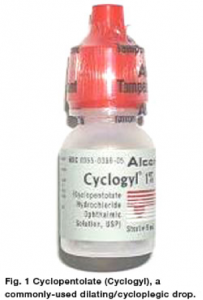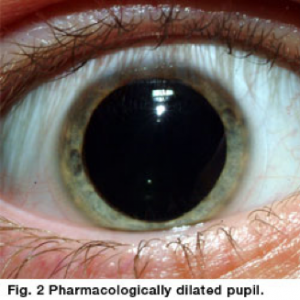What are dilating eye drops?

Dilating eye drops contain medication to enlarge (dilate) the pupil of the eye. There are two types of drops: one type stimulates contraction of the muscles that enlarge the pupil (such as phenylephrine); the other type relaxes the muscles that make the pupil constrict and also relaxes the muscle that focus the lens of the eye (such as cyclopentolate). These two kinds of medications are often used together, either as two separate drops or as a single combination drop. Sometimes the drops are given via spray.
Why are dilating drops necessary?
A large pupil allows the doctor to examine the inside of the eye in order to diagnose and treat eye diseases. Also, relaxing the focusing muscles of the eye allows for a more accurate measurement of refractive error (need for glasses) in children. Finally, dilating eye drops are sometimes used to treat eye diseases or conditions, such as amblyopia, inflammation, or progressive myopia (nearsightedness).
How long do dilating drops last?
Dilating eye drops used for examination of the eyes usually last from 4 to 24 hours, depending upon the strength of the drop and upon the individual patient. Pupil dilation tends to last longer in people with lighter colored eyes (irides), and occasionally a child’s eyes may stay dilated for longer than 24 hours. Children require stronger and longer lasting drops than do adults to accurately measure refractive error. Weaker drops are used for premature babies and neonates. Dilating eye drops are occasionally used to treat certain eye diseases, such as amblyopia and inflammation in the eye. These therapeutic dilating drops (atropine and homatropine) may have a longer duration of action, even up to 2 weeks. Despite the longer duration of action, daily administration of the drop may be necessary for treatment. When treating progression of nearsightedness (progressive myopia), a much more diluted concentration of atropine is used limiting potential side effects.
What are the side effects of dilating drops?
Light sensitivity and blurry vision (especially for near tasks) may be noticed. Both side effects gradually disappear. Sun glasses may be helpful after a dilated eye exam. Children can return to school, but teachers should be aware of blurred vision while reading. Allergic reactions are rare with drops used for examination, but include lid swelling and red eyes. Side effects from atropine (which has a longer duration of action) include fever, dry mouth, flushing of the face, and a rapid pulse. Rarely atropine can cause a new onset of eye crossing (esotropia), or worsen an existing esotropia. For the treatment of progression of nearsightedness (progressive myopia), atropine is used in a much lower concentration (0.01%), thus decreasing side effects such as blurred vision at near and dilated pupils.

Do dilating eye drops burn or sting?
Like most eye drops, there is generally some stinging immediately after instillation. This is usually momentary. A topical anesthetic (numbing drop) can be used prior to the dilating drop to increase patient comfort.
Credits: Journal of American Association for Pediatric Ophthalmology and Strabismus